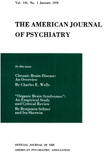CHLORDIAZEPOXIDE AS ADJUNCTIVE THERAPY IN CONVULSIVE DISORDERS
Abstract
Eighty-five of 86 patients starting treatment were evaluated. One patient after 5 days of treatment developed clinical jaundice and was discontinued from the series. Prior to treatment 76 of 85 patients (89%) had fair or poor control of seizures. Following the use of chlordiazepoxide 56 of 85 patients (66%) had fair or poor control. The dosage used was 10 to 60 mgm. daily. Chlordiazepoxide appears generally to be compatible with the currently available anticonvulsive agents. Undesirable side effects, such as somnolence, ataxia and vertigo, were mild and relatively insignificant except at the highest dose. In spite of this chlordiazepoxide appears to be an effective adjunctive treatment in seizure disturbances.
Access content
To read the fulltext, please use one of the options below to sign in or purchase access.- Personal login
- Institutional Login
- Sign in via OpenAthens
- Register for access
-
Please login/register if you wish to pair your device and check access availability.
Not a subscriber?
PsychiatryOnline subscription options offer access to the DSM-5 library, books, journals, CME, and patient resources. This all-in-one virtual library provides psychiatrists and mental health professionals with key resources for diagnosis, treatment, research, and professional development.
Need more help? PsychiatryOnline Customer Service may be reached by emailing [email protected] or by calling 800-368-5777 (in the U.S.) or 703-907-7322 (outside the U.S.).



